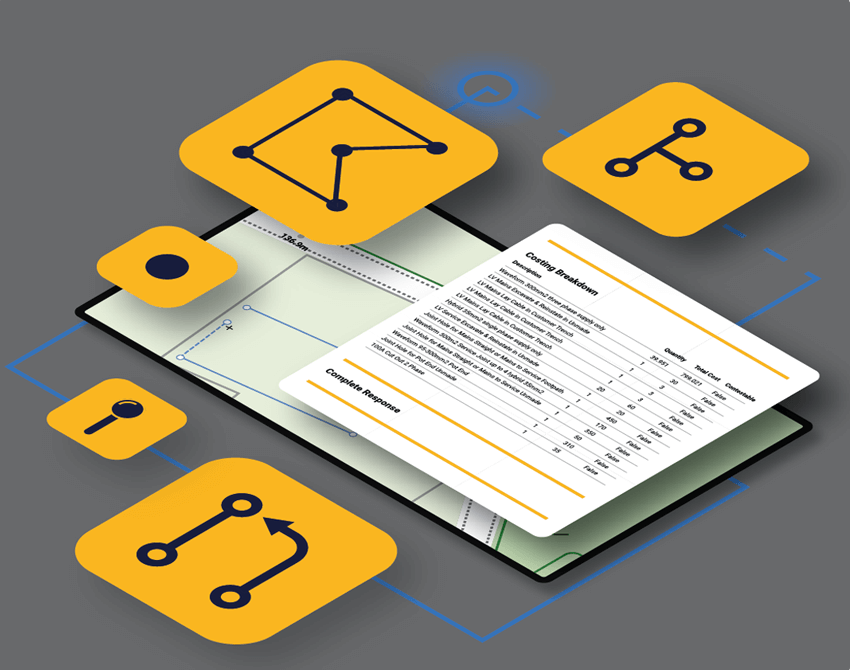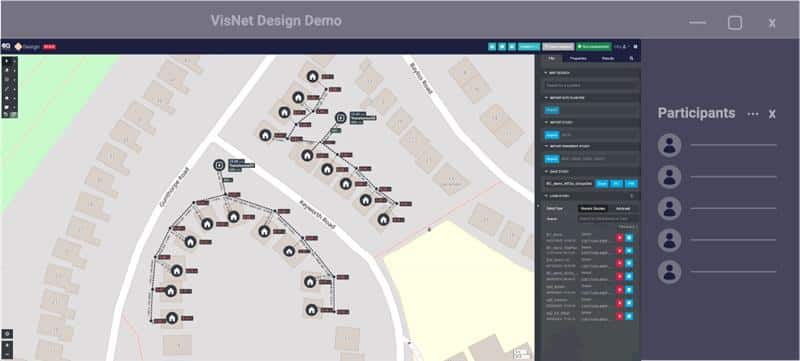Model and assess tomorrow’s electrical networks

Low carbon technologies and local generation are putting increasing strain on electrical networks. Under pressure to adapt networks to meet these needs, network designers need intuitive and fast low voltage network modelling software tools. So they can quickly assess the impact of new connections on safety and the bottom line.
Built on decades of network design experience, VisNet® Design enables connection providers and network operators to rapidly design and evaluate networks. Allowing for easy assessment and iteration and accelerating the speed between request and fully costed design. Trusted by over 550 planners across 19 companies, it is an essential tool for efficient and effective network planning.
VisNet® Design also includes backwards compatibility with WinDEBUT, ensuring a seamless transition for your existing projects.

WinDEBUT, the predecessor software to VisNet® Design, will be coming to end-of-life on 30 January 2026, at which point it will no longer be supported
Benefits
- Model new connections – solar panels, EV charge points etc. on existing electrical networks.
- Conduct cost and safety analyses of new connections using industry standard calculations.
- Minimal Training Requirements – Easy to use web application with minimal training required.
- Rapid Assessment – Quickly evaluate complex networks, reducing time from request to design.
- Centralised File Management – Access and manage saved models effortlessly.
- Easily model existing DNO network as single line and load.
- WinDEBUT backwards compatibility – ensuring a seamless transition for your existing projects.
Features
- Rapid – easily models existing DNO networks as single line and load.
- Easy to use – intuitive web application that works on a variety of devices.
- Cost effective – clear simple pricing model to meet a range of budgets.
- Map View Overlays – Network schematic and assessment results shown overlaid on a map view.
- Enterprise Version – Available with GIS data integration for enhanced planning.
- Automatic Updates – Easy deployment with automatic updates ensuring the latest features.
Interested in seeing VisNet® Design in action?
Other VisNet software solutions
Ensure your network is future-ready with our range of scenario modelling, connections and design modelling

VisNet® Connect
VisNet® Connect
Optimise workflows and automate quote generation using our VisNet® Connect Low Voltage (LV) network optimisation tool. Empower your customers with self-service tools.
Frequently Asked Questions
Compatibility & Integration
Does VisNet® Design work with existing WinDEBUT projects?
Yes, VisNet® Design is fully backward compatible with existing WinDEBUT studies, allowing users to import WinDEBUT files (including .WDF, .WDO, .WDI, and .GEN files) directly into VisNet® Design. Legacy designs can be opened, updated, and re-assessed using VisNet Design’s enhanced analysis engine and intuitive interface. This enables an effortless upgrade from legacy systems while preserving valuable design data and workflows.
What file formats can I use with VisNet® Design?
VisNet® Design can save and import JSON files to share VisNet® Design network study files, migrate existing WinDEBUT study files seamlessly, and import or save PDFs for site plans and reports. This flexibility ensures smooth collaboration and easy integration with your existing tools and teams.
User Suitability & Deployment
Is VisNet® Design suitable for both connection providers and network operators (DNOs)?
Yes, VisNet® Design is purpose-built for both Distribution Network Operators (DNOs) and Independent Connection Providers (ICPs), offering a unified platform for Low Voltage (LV) network design and assessments. Over 30 organisations and more than 650 engineers already rely on it to deliver fast, consistent, and accurate connection studies. By streamlining complex design tasks, it enables engineering teams to work faster and more efficiently, improving customer response times and consistency in design quality.
What is the source of the map background on VisNet® Design?
VisNet® Design features a live, interactive map (powered by OpenStreetMap), covering the UK and Europe. It includes map and postcode search with autocomplete capabilities, along with a PDF site plan overlay option for network designs. This provides instant geographical context, making network layouts quicker to build and easier to understand.
Network Design & Modelling
What types of networks can I model with VisNet® Design?
VisNet® Design supports full Low Voltage (LV) network modelling including transformers, feeders, mains and service cables, customers, and distributed generation. It accommodates single–, two–, and three–phase networks, both balanced and unbalanced, with support for both grouped and distributed connections. The platform is designed for star-configured radial network modelling, ensuring fast, reliable assessments for standard LV configurations. Interconnected networks can be designed using link box and fuse link open points. While meshed network modelling is not currently supported, it is included on the product roadmap.
How does VisNet® Design speed up the assessment process for new network connections?
VisNet® Design automates many manual design steps. Its transformer and cable auto-sizing functions help identify the optimal sizes to meet network demands and operating conditions. Cable lengths are automatically calculated, and load-flow and voltage assessments are performed rapidly. Distributed connections on conductors and transformer load addition functions can significantly reduce the time and effort required for network design. Users can also make bulk edits and updates using the group select function, and leverage undo/redo tools for rapid design iteration. These features streamline the process, minimize manual effort, and accelerate overall design time.
Can VisNet® Design model Low Carbon Technologies like EV charge points, solar PV?
Yes, VisNet® Design includes built-in demand and generation profiles for EV charge points, heat pumps, solar PV or other generators, alongside standard domestic, commercial, and industrial profiles. These can be modelled as grouped or bulk connections, making it easy to assess how low carbon technologies (LCTs) will affect LV network performance.
Does VisNet® Design calculate voltage drop, rise, and utilisation on LV feeders?
Yes, VisNet® Design performs comprehensive Low Voltage (LV) network analysis, including voltage drop and rise, load flow, utilisation, impedance, and fault current calculations. It gives network designers a complete technical view of network performance, ensuring that designs are compliant, efficient, and reliable.
Can I run time-series or seasonal simulations on VisNet® Design?
Yes, VisNet® Design provides seasonal result views, allowing engineers to review summer, winter, or all-season conditions for voltage, current, and demand. This ensures designs are resilient and reliable year-round.
Does VisNet® Design include diversity factors or demand profiles for load modelling?
Yes, VisNet® Design includes built-in demand profiles and offers various demand type options for each type of customer. Load can be modelled to either include or exclude diversity effects for each customer, and to represent either a known maximum demand or an estimated annual consumption. Each load profile is based on real-life data and reflects realistic behaviour both across the day and across multiple seasons to enhance accuracy in network assessments.
Standards & Compliance
Does VisNet® Design comply with IEC or UK Engineering Recommendations?
Yes, VisNet® Design is built based on the same statistical principles in WinDEBUT with a consistent methodology for network assessment. It aligns with ENA Engineering Recommendations such as P28 (Voltage Disturbance or Flicker) and most aspects of P5 (Design of LV Underground Networks). With respect to P5 Issue 6, VisNet® Design uses an enhanced voltage rise methodology and improved LCT profiles that outperform those in WinDEBUT. It also supports various UK DNOs’ configuration to align with LV design policy. This ensures that the assessments meet established UK and IEC standards and are accepted by various UK DNOs, simplifying design reviews and reinforcing confidence in the results.
Is VisNet® Design recognised by UK Distribution Network Operators (DNOs)?
Yes. VisNet® Design is the modern, cloud-based successor to WinDEBUT, the proven Low Voltage (LV) design tool used by DNOs for decades. VisNet Design offers more comprehensive and user-friendly features that streamline LV network design work. It has already been adopted by DNOs, IDNOs, and ICPs across the UK as the trusted, next-generation solution for LV network design and modelling.
Sign up to our newsletter
Learn more about our market-leading products and how we’re supporting the world’s transition to decarbonisation.





